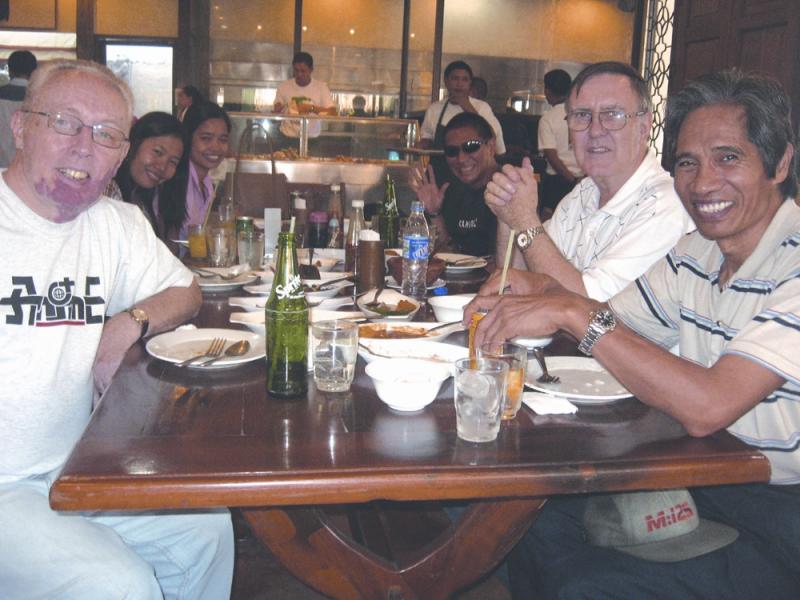Misyon Online - September-October 2007
Beauty In Suffering
Sr Anne Carbon SSC
Sister Anne is from Cagayan de Oro and worked as a nurse before becoming a Columban Sister. She qualified in mental health nursing in England. Her article shows how important that is as she works with children traumatized by years of terrorism in the area of Peru where she lives.
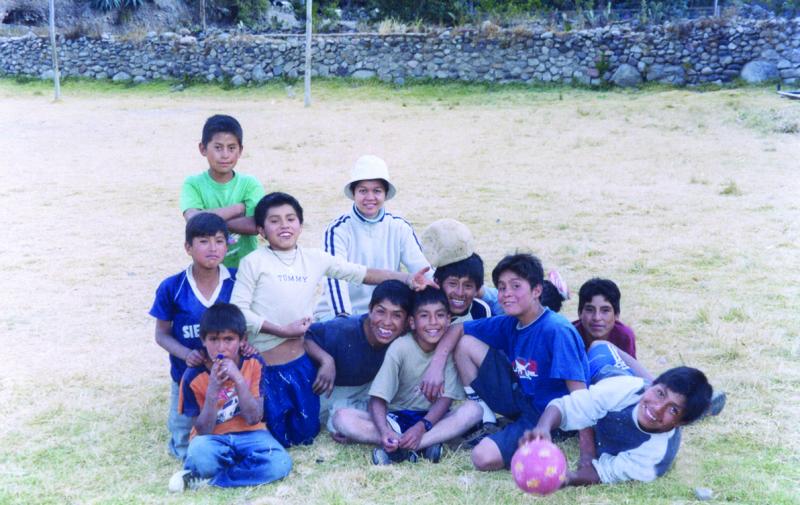
Sr Anne with the Children
Childhood is a very special time and space for everyone. When one is young the whole world is like a playground where one can explore freely and with wonderment everything that one sees, hears and touches. There is so much innocence in a child’s heart, the exploration and discovery is filled with joy and laughter.
I remember the many escapades that my brothers and sisters did to the annoyance of adults, especially my parents. But my siblings and I had so much fun together that recalling them now only makes my heart burst with song and laughter. Recalling the joys of my childhood brings nothing but happiness to my heart and a deep gratitude to God for giving me that special time and space in my growing-up years.
Old too soon
When I was a novice my pastoral ministry took me to places that were labeled poor, depressed and marginalized. The reality that I saw in those places shocked me beyond belief. I saw children malnourished, dirty, eating on top of garbage trucks, working very early in the morning until late at night selling candles, cigarettes or flowers. The children whom I saw had worn-out faces. Young as they were they were already the breadwinners of their families. They seemed to have lost that time and space called childhood.
I have been in Peru as a religious missionary for the past seven years. A few years ago the Columban Sisters opened a mission in Vinchos, a place situated in the high mountains of Peru where the notorious terrorist group called ‘Sendero Luminoso’ (Shining Path) used to have their headquarters for many years. They are gone now but they left broken people many of whom are mentally depressed. A good number of these mentally depressed people are children.
Disturbing reality
I was deeply touched by the reality I saw that I started sharing my concerns with some of the men and women in the town. To my surprise I found out that we had the same concerns. Some of us approached the Director of the only school in the town to help us do something for the children. With his help we were able to track down around 20 children whose ages ranged from 7 to 12. They were either passive-aggressive, low in academic output, had difficulty in concentration or escapees from school.
In the eyes of a child
Our first activity with the children was a drawing/painting contest. The results showed that they knew how to express themselves and that they knew what was going on around them. What struck me most was that a lot of them expressed the desire to die. A few of them even had details on how to do it! One painted a cemetery and when I asked him why, he said, ‘It is a peaceful place, nobody bothers me there.’ Another drew a coffin and said, ‘I want to die and be with my father.’ His father was killed during the political violence and he was living with his mother and stepfather who was violent to him and his mother. Another painted a river and put himself floating in it. He said, ‘I want to get drowned and die.’ Although the results were alarming, the good thing was we were guided in our initial approach to reach out to the children
Hopeful spark
Not wasting time, I went to Lima to look for a child psychiatrist. Luckily I found one who was willing to make that long journey to the mountains to see the children. Together with the lady psychiatrist, I drew up a simple program starting with a once-every-two-months psychological attention given to the children. Sister Mary Nolan and I do the follow-up after her evaluation of each one of them. These individual evaluations are kept in a file so that our follow-ups are done accurately. Right now some are receiving pharmacological treatment. While receiving treatment there are also activities that facilitate them to express themselves like painting, drawing, working with plastiline, workshops on emotional therapy, social activities that will bring out their abilities, individual sessions with the children and home visitation. We found out that visiting the families is an effective tool as it helps us to get to know more the family and the real situation they are in.
After a few months of following this program, a tremendous change in the children was very noticeable. Thoughts of death and the desire to die have gradually disappeared. They are more relaxed now and they are able to express their emotions of fear, anxiety and anger. Their grades in school have improved and violence in the family has lessened or has disappeared.
I feel I have created a special bonding with these children. I also feel that I have bonded with the many people who are involved in this mental health program. I feel my life is connected to each one of them. Working in the area of mental health has been a very enriching experience for me. It has offered me a wider range of understanding what life is all about.
Earning back what they’ve lost
As I continue participating in the lived reality of the poor here in Peru, I am able to see beauty beyond their sufferings. I feel that working with the children has enabled me in some little way to let them experience the joys and laughter of that special time and space called childhood.
You may email Sister Anne Carbon at musuq-05@yahoo.com.
Father Joeker
By Fr Joseph Panabang SVD

‘MOUTHED’ PRAYERS
A Catholic woman was bitten by a deadly poisonous snake at Njao, one of my outstations. Rushed to the hospital she survived. ‘While being carried what did you do?’ I asked her during the catechism class. ‘I placed my rosary in my mouth, Father.’
The catechist turned to me saying, ‘Now, I understand why she said a while ago she could not pray then’.
UNSOLICITED INFORMATION
I just brought home two puppies. The curious one I named ‘Love’. That afternoon, Love was sticking her head out looking at the woods nearby through the window. ‘What are you doing there, Love?’ I asked. ‘I went to the toilet,’ replied a boy who was passing by. I could hear our cook giggling in the kitchen.
Forgiveness And Inner Healing
By Joy Ampiloquio
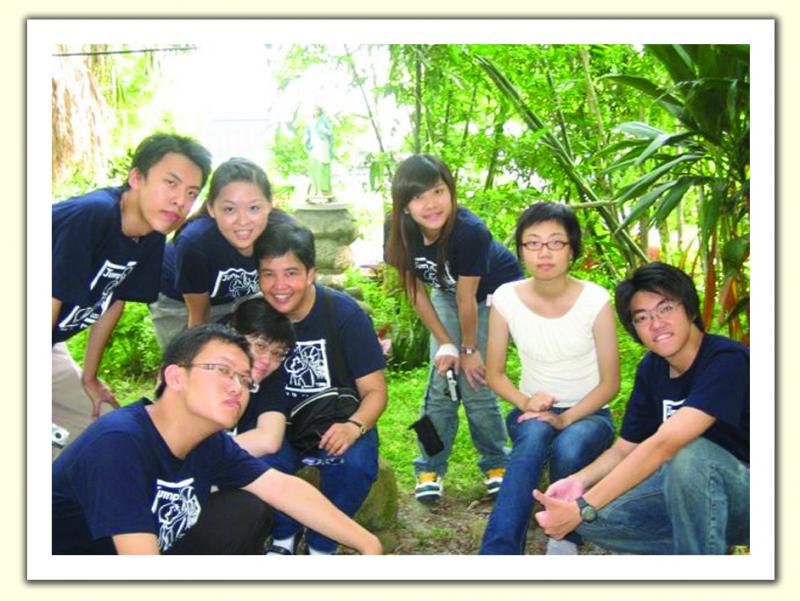
Peter came up and asked Jesus, ‘Lord, when my brother wrongs me, how often must I forgive him? Seven times?’ ‘No,’ Jesus replied, ‘Not seven times; I say, seventy times seven times’ (Matthew 18:21-22).
Stricken with guilt
There was a release of guilt on her part. Guilt, as defined by the dictionary, is a condition of having done wrong. It is concerned with a deed which has violated certain norms. ‘The violated norms involved in guilt are often, but not always, moral’ (Aaron Ben Ze’ev: The Subtlety of Emotions, p. 498). We feel guilty after doing something which is forbidden and it typically involves some harm to another agent. This student felt guilty and, at some point, thought that her impulsive action was wrong. When people feel guilty, they try to repair what they have done by apologizing, explaining themselves, offering excuses, confessing and making amends.
First, yourself
Stricken with guilt, she made a move, an initiative to go to someone she could trust and unload or release her guilt. I am reminded of another story from the Bible (Luke 15: 11-31) about a prodigal son who realized his wrongdoing after experiencing suffering. He made a move to return back to his father’s embrace. The student came out from my office feeling better and was assured of God’s forgiveness. She had courageously faced her situation by forgiving herself, asking forgiveness from her own father and was accepted back home. A healing of the heart had taken place.
Childlike heart
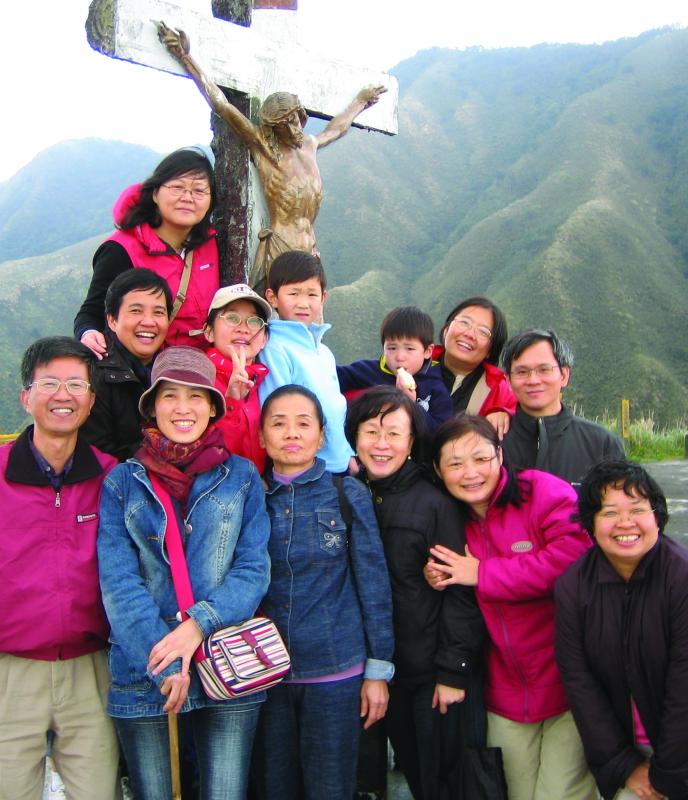
What is your earliest memory of forgiveness? It is said that ‘Children are certainly much more forgiving than adults’. (Leo Buscaglia, Born for Love, p. 202) Even among peers, children are quick to patch up or reconcile, without holding any grudges against each other. When I was a child, I was stubborn and active which means I was very susceptible to punishment or scolding from my parents, especially my dad. However, I was always quick to admit my wrongdoing, apologize and would feel good about myself. Life then went back to normal and I would still feel loved by my parents.
Hurts of the past
However, when we become grown-ups, it seems more difficult to admit our mistakes or humbly ask for forgiveness from those whom we have offended or to forgive those who have wronged us. Do we ever ask why? Is it because we have wounds or negative memories from the past which are not completely healed? Have we really forgiven our parents for our childhood hurts? Have we forgiven our enemies or friends who have deeply hurt us? Perhaps many of us have forgiven in our minds but only partially in our hearts. Healing comes through the uprooting of negative memories or hurts caused by others in early childhood. Lack of forgiveness on our part affects how we react to future circumstances and relationships.
Forgiveness is a tablet that we must swallow in order to get well. It might not taste good going down, but it begins the healing process.
Barriers to forgiveness
There are many barriers to forgiveness. One of the greatest difficulties is when we don't even realize that we still carry resentment and thus need to forgive. Problems in our current emotional, spiritual and physical lives are good indicators. ‘People almost invariably think they have forgiven when they haven't. And how shall we know? By simple, pure logic according to God's Word. If the problem is still there, forgiveness is incomplete’. (Sanford 1982:101)
Another great barrier to forgiveness is the simple fact, that because the other has caused us so much pain, we don't want to forgive. Sometimes we are afraid to forgive others because it seems to give them the power or permission to hurt us again. But actually the contrary is true. It is when ‘we do not forgive that we continue to give people negative influence over our thoughts, our actions and, as explained above, even our bodies’. (Flynn and Gregg 1993:94)
What forgiveness is and what it is not
Joy Ampiloquio, from Bislig City
Surigao del Sur, and a member of
the Teresian Association, with pilgrims in Taiwan.
It is important to understand what forgiveness is and what it is not. Forgiveness is most basically a release of our anger against someone unto God. ‘When we forgive, we release the one we have been holding something against from our anger, bitterness, resentment and desire for revenge. We do not declare that person ‘not guilty’. Rather, we recognize his or her guilt and give to God our right to pay the person back’. (Kraft 1993:153) Forgiveness is not denying the pain of an event or saying that it was okay for someone to hurt us. ‘Forgiving is not forgetting. Forgiveness does not mean that you must tolerate sin. Forgiveness does not demand revenge or repayment for offenses suffered. Forgiveness means resolving to live with the consequences of another person's sin’. (Anderson 1990:201-2) Forgiveness and the giving up of anger are also not spiritual denial. ‘It requires honest facing of our feelings and admitting that they are there. God requires complete truthfulness. God only heals those who face the facts and give the heavy burden of such feelings to him’. (Kraft 1993:155)
‘You will always be a victim until you forgive.’(Stephen Covey, The Seven Habits of Highly Effective Families, p. 60) You can cleanse your own heart and also remove a major obstacle that keeps others from changing because when you don’t forgive you put yourself between people and their own conscience. Forgiveness comes only when we can identify with others and admit to our own imperfections and an equal capacity for wrongdoing.
Be a healing presence
Go and reconcile with yourself, others and God. Become a ‘wounded healer’. Be a healing presence to others. Many times, you and I would hear: ‘I feel better talking with you; I feel good being with you.’ You and I at many points in our life have stumbled, been wounded and stood up again. We made a choice to heal ourselves and become a healing presence to others.
Garding
By Eden Po
This is not a story of an old lady who saved the world but rather a memento of a beloved woman who captured many hearts.
By Eden Po
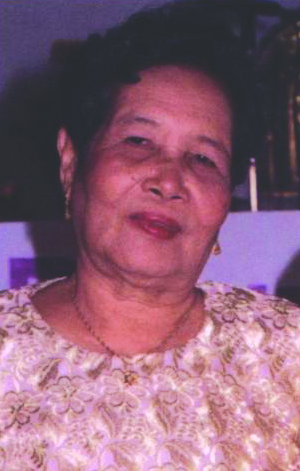 This is not a story of an old lady who saved the world but rather a memento of a beloved woman who captured many hearts.
This is not a story of an old lady who saved the world but rather a memento of a beloved woman who captured many hearts.
Mrs Lutgarda T. Bayona, a woman unfamiliar to most of you, passed away on 21 October 2005. She was a bride of Christ in words and deeds.
Mrs Bayona was a teacher by profession. She had been assigned to many schools around Himamaylan City and Binalbagan, Negros Occidental. I was not around then when she was teaching a great number of students, but I know she did a wonderful job, as seen in the lives of her beloved children and grandchildren.
‘Ma’am’, as many called her, was very active in our parish church. She was one of the leaders of the Legion of Mary (www.legion-of-mary.ie) who did good works and inspired many people. She was also one of the officers with great responsibility in the Catholic Women’s League. She really gave a great deal of her time serving other people.
I was awed by her unique strength. Age didn’t really matter to an old woman like her because the love of Jesus consumed her heart. The distribution of copies of
Misyon was one of her responsibilities. She went from one place to another to deliver it to subscribers.
She also helped in sending students to the seminary. She asked and collected donations from generous people so that the seminarians might continue their studies. She loved to do a lot of these charity works even with her weak knee.
Garding’s death doesn’t really mean her loss because she started a legacy worthy of being honored and followed. Her influence, examples, ideas and values will live on no matter how far into the future.
Her death calls for a reunion not only of our family but also of her friends and fellow Binalbaganons. The reunion she once planned wasn’t disregarded. She made a call, we answered. Her love will always continue to flow in our hearts.
Mrs Lutgarda T. Bayona, my grandmother, created a journey of no boundaries for my generation. I am so blessed to live the life that I have and my lola helped pave the road for my family and me.
You may email the author at mecbp24@yahoo.com.
In Rainbow Colors
By Mitzi Ramos
Who knew that a letter of appreciation would be the beginning of eighteen years ' heavenly humor from the mission front to the lap of urban readers? This is exactly how the experiences of an isloated Ghanaian missionary found their way into the pages of Misyon. It is my pleasure to introduce the real Father Joeker. From Joseph Panabang SVD.
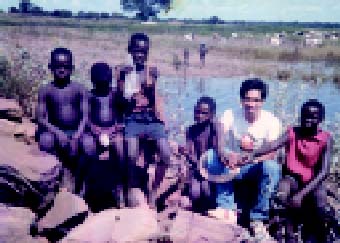
Cream of the crop
After finishing his elementary education he naturally first entered the CICM seminary. After a time he left the seminary to study at St Louis University in Baguio City. He finished his degree in BSN Sociology in 1978, working while studying. He strove to remain at the top of his batch for a fifty percent scholarship. He made his way to the SVD seminary in response to the unceasing call to the priesthood. During his regency (time spent by the seminarian outside the seminary to take a rest or to explore the realities of `real' life), Father Joe taught at the Divine Word College of Laoag. Despite his being a favorite among the ladies, he confessed to having no interest in pursuing any of them. The call still resounded in his heart, so back to the seminary he went and to his eventual ordination in 1986.
Free to soar
Nearing his ordination, he relates how easy it was for him to fill out the form that asked how he wished to allocate his worldly possessions. Being the youngest of twelve he had no worldly possessions to apportion to relatives and friends. He felt freedom and joy in that realization especially when his family signed the document that declared he no longer had any obligation nor ties to them. He, from the moment of ordination, belonged to God and His people.
Gaang to Ghana
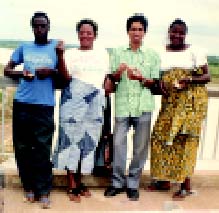
Fr Joe's color
Red passion is what colors Father Joe's efforts to be one with the Ghanaian people. When he first arrived, he gamely walked with them to get to the next town. They are used to walking the whole way, even as far as ten kilometers, without stopping to rest! Father Joe walked with them at night to avoid the extreme heat during the day. After a while, he introduced the concept of stopping to rest along the way. He created resting spots which later on came to be known as osofo _ the `priest's resting place' which the people have since then learned to use as well. Passion enables Father Joe to persevere when he undertakes tasks which at first seem quite foolish to the people around, like his idea of developing an ecumenical prayer place around a waterfall. When he was building the place, he had a lot of critics standing around watching him. Yet these same people now use the prayer place for their own leisure and activities.
The bright side of life
Father Joe's ability to find the brighter side to most situations stems from his belief that the more you defend yourself, the more energy you use, but once you use humor . . . you free yourself from unnecessary tension. His good spirits are also bolstered by the joy he finds in serving. Contentment is his when he focuses on simple things like lying down at the back of his car at night on his way to distant villages. With a mosquito net to cover the opening, and the wide expanse of the night sky right overhead, Father Joe finds sleep quickly.
No harm in asking
His positive spirit, sunny disposition and serenity are rooted in the experience of having learned a few things about life along the way. First, he has learned to always ask questions. There is no shame in not knowing something especially when dealing with a different culture. For example, the Ghanaians consider it an insult if you talk to animals in their presence. They believe that you are actually talking about them or making a snide comment regarding them. Father Joe had to explain from the pulpit that speaking to animals is not done to insult any Ghanaians within hearing but is a way of showing affection to our pets. He wouldn't have known about this cultural trait if he hadn't asked.
God's words, not his
Second, there is a proper time for a certain learning to take place. One cannot force another person to learn when he is not ready for it. He is of the conviction that it's not always about you. He has had numerous experiences of giving homilies wherein the parts which he felt had no impact were actually the portions people would thank him for later. From these moments he has come to recognize that he is not the only one at work in the mission fields. He sees that God is in control and that he need not be proud of `his' work or stressed when things don't go the way he had planned. He has learned to accept that he cannot understand everything at once and that it's actually okay.
Lastly, Father Joe asks the question, `Masaya ka ba? (Are you happy?)'. Your answer indicates whether you are doing what you were made for. Everyone wants to be happy. If one is not happy, it will manifest itself somehow. This
`measurement' can be applied to the question of vocation. For Father Joe, the religious life is where he is happiest. If a person is really called and tries to ignore it, the end result is always misery. The same is true for those who insist that they have a vocation to the religious life thinking it is the noblest way to love God yet they know that they are called to a different vocation. Again, for him, you cannot force something you were not made for. He considers the religious life as a reminder to others that there is another way of loving God and that this particular way should not bring you fear. A love for your vocation will result in a happy person _ happy priest, nun, brother, single or married person. This same love helps when dealing with the difficulties inherent in the vocation you have chosen. Quoting Father Joe, `If you do not appreciate your vocation, it is a warning sign. . . .'
Incurable sickness
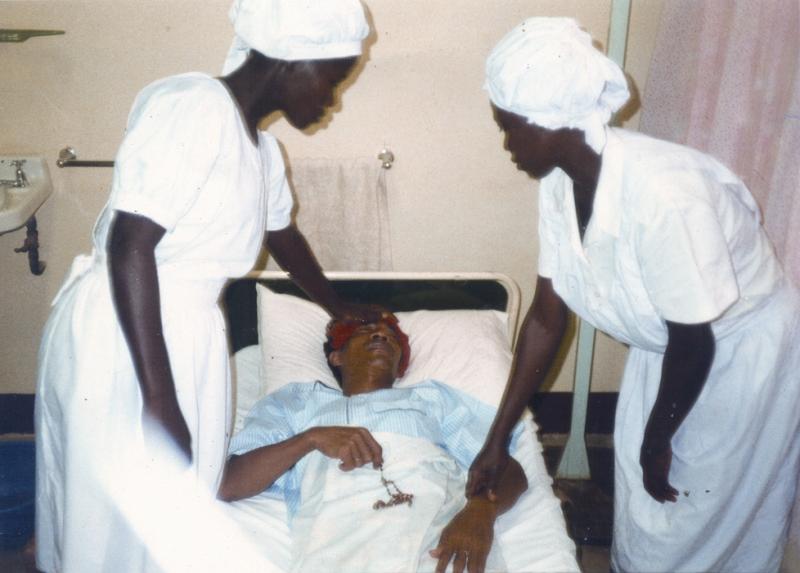
Father Joe has allowed his mission post, its people, with their everyday struggles and triumphs, to affect him, to make a place for themselves in his heart, right alongside the place where his native village resides. `When God takes you away, God will also send someone to take care of those whom you leave behind', was his reflection upon his first visit home to Gaang. He almost cried when he saw that his own village had been neglected in terms of the people receiving the sacraments like Baptism, Anointing of the Sick, Marriage, Reconciliation and the Holy Eucharist. In contrast to how he took great pains to ensure that during his absence the people in his Ghanaian parish would be able to avail of these life-giving sacraments, his own people had not received a visit from a priest of the diocese for years. At first he felt guilt in leaving his own people behind to bring the Good News to the people of a foreign land yet, as the bishop of his diocese reassured him, God will send a replacement. True enough, a few years after, on his next home visit, Father Joe saw that God had sent someone to care for his own village. This convinced him that there is no need to worry for God takes care of ALL his people. Lessons from Father Joeker
Though we know Father Joe more as Father Joeker and his quips have brought smiles and even laughter for the past eighteen years, he is far from being shallow. In contrast, his joy is one that is constant for it stems from seeing, recognizing and rejoicing in the presence of God in everything and in everyone.
Feasting with Fr Joe, Fr John O' Mahony SVD
Fr Sean Coyle and Misyon Staff
Trying to put Father Joe into words is like trying to hold a rainbow in one's hands. He is made up of so many facets, one as colorful as the next. He is the red of passion for his vocation, the orange of a positive spirit, the yellow of a sunny disposition, the green of a hopeful outlook towards circumstances, the blue of a serene trust in God's greater design, the indigo of a compassionate heart, and the violet of shared sorrow with the people he comes from, his native Kalinga, and the people he has chosen to walk with, the Ghanaians.
Lufthansa Encounter
By Veronica Ugates
The author is one of Misyon’s regular contributors. She has recently come up with her own magazine, HEROES – a magazine dedicated to our overseas Filipino workers. It has an online version, www.heroesmag.com. She is currently working on her book Questions Women Ask About Their Men.
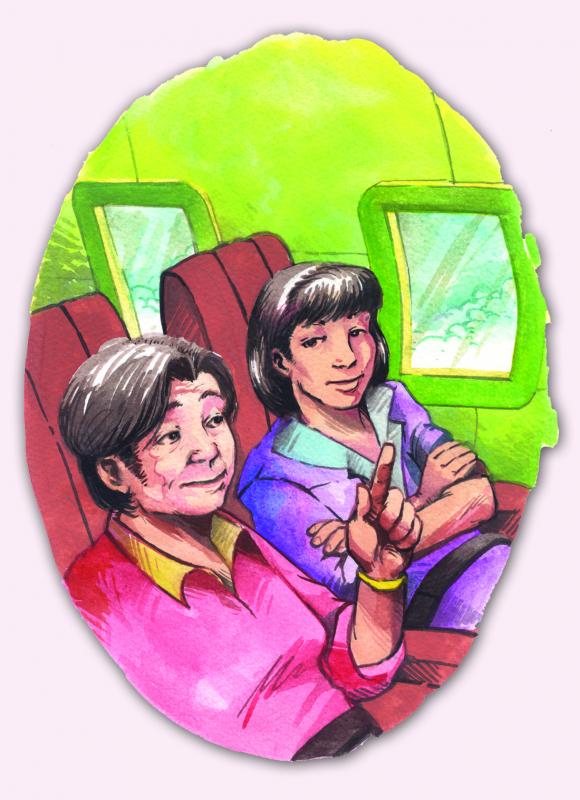 Lufthansa flights from the Philippines to Tripoli have two stopovers, one in Bangkok and the other
Lufthansa flights from the Philippines to Tripoli have two stopovers, one in Bangkok and the other
in Dusseldorf. Returning to Tripoli on the second leg of my trip, I was seated beside a Malaysian lady.
Apparently, she had been observing what I was doing and after I had prayed the rosary she asked me, ‘You’re Catholic, right? What makes you different from others?’ I replied, ‘Hello! Oh, there would be a number of things but I’d venture to say our faith is the most difficult to follow yet it is most practical’.
A curious exchange
‘Why is that?’ she asked. ‘Well, the main difference would be that our faith calls us to sacrifice, and not just any ordinary kind of sacrifice, but with a free and willing heart. That is why we embrace the cross as a symbol of that willingness to suffer. Yet, we are told that the greatest sacrifice may not be enough unless the grace of God is also bestowed. So you may be doing and giving your utmost but it still is up to God whether He would accept that sacrifice as an offering to Him’, was my reply.
‘Really’, she commented. ‘You mean there is no guarantee? None at all?’ I agreed. ‘Is that not the same as what others do?’ she questioned. ‘Well, no,’ I said. ‘I have noticed that others are fond of quoting the Bible verse that goes, “Ask and you shall be given, look and you shall find, knock and the door will be opened to you”’. ‘Don’t you do that as well? she said. ‘Personally, no. I usually pray for safety and good health like now’, I said, ‘but to receive all other blessings will be a bonus. I do know that a lot of others do’. I conceded ‘But at the same time we are aware that there is no assurance that it will be given because it is all in God’s hands. After all, if everything on this earth belongs to Him, then He can do with it as He pleases. So mainly, we pray that we can accept and bear whatever may happen to us in this life’.
‘Is that not a defeatist attitude?’ She said. ‘Well, I guess, you can look at it that way but it allows us to prepare for anything that can happen along the way. After all, nobody can say what tomorrow brings or even one hour after the next, right? So it is a matter of being prepared all the time. And when you look at it that way, even the greatest disaster can be accepted with humility. Besides we really can do nothing about it when it happens so why not accept in good grace?’ was my reply.
‘But what is the point if you cannot expect some compensation for doing right?’ she asked again. ‘Ah, but we do hope for compensation, just not in this life,’ I said.
‘Well, yes, but you are not even sure that you’ll get it,’ She said. ‘That is true, but then who is sure of anything anyway? Are you sure that what you believe in is right? Who said so? And if anybody had said so, what proof does he have for saying so? So you see, we are all in the same boat. So why not just accept and believe. I think it is easier’, I said.
‘But if you do that then you have no control over your life.’ She said. ‘Perhaps’, I said, ‘But even if you strive for control, it will always be just up to a point. After that it still is all in God’s hands’.
‘So why do you say it is practical?’ She asked, going back to my first observation. ‘Well, I believe it is practical because the Church provided us with the sacraments as guides from birth to death’, I clarified.
From womb to tomb
‘What are sacraments?’ she asked. ‘They are a sort of rites of passage we undergo as we grow and mature in our faith until we die. For example, we are given the sacrament of baptism at birth or as early after birth as possible’, I replied. ‘Isn’t that a naming ritual?’ she asked again. ‘Not really, though you are given your name at the same time. But it is more a ritual of acceptance into the Catholic faith. And it gives you the privileges of being Catholic, so in case you die prematurely, you are assured of going to heaven’, I elaborated.
‘How do you know you’re going to heaven?’ she asked. ‘Well if you are still a baby I am sure God would have no objection to accepting you into His Kingdom, would He?’ I pointed out. ‘It is practical because it gives us the advantage of knowing where we will go if we die young, and not float somewhere in an unknown world’, I said.
She was silent for a while. So I added, ‘Then we also have confession’. ‘What’s that?’ She was curious. ‘If we commit sins we go to the priest to confess them’. I explained. ‘Why would you do that?’ she asked. ‘You see, if we commit something wrong our conscience will bother us. But once it is confessed to the priest he absolves us and sets us free from thinking about it. I imagine that is the reason why with the millions of Filipinos, the rate of insanity is almost insignificant, because we have this escape from all those burdens’, I elucidated.
‘Why do you have to do that? Can you not just confess directly to God?’ was her next question. ‘No’, I said. ‘In fact, that is one reason why I said our faith is more difficult to follow. Which is easier to do - to confess to another human being or to tell it directly to God?’ I asked. ‘Well,’ she said, ‘what if the priest talks about it?’ ‘No, he cannot’, I explained. ‘They have the vow of secrecy. They cannot divulge the things told in confession’. ‘Even if it is murder?’ she asked. ‘I guess so’, I said. ‘And if it is as grievous as that, then you can just imagine the burden he carries. That brings us to another reason why I think our faith is more practical. The priests have the vow of celibacy. They cannot marry once they are ordained priest.’ ‘Why should that be practical?’ she asked. ‘Well’, I said, ‘We all know how curious women are but our priests need not put up with the curiosity of a wife’. I laughed and she laughed with me.
‘On top of that, a priest can take care of his community without any hindrance. He can devote the whole of his time to God and his flock. What is more practical than that?’ I finished. I guess I could have elucidated further than the very superficial things I told her. On the other hand our faith is not that easy to explain to a person of another belief so I opted for the more light-hearted exchange. However I did hope it had planted some seeds in her that will be fruitful someday.
You may write Veronica Ugates
c/o Dionisio Cadag
#6 Mars St
Villa Cristina Subdivision
Punta Princesa , CEBU CITY
Or email her at vugates@yahoo.com
Matt Talbot – The Workers’ Saint
By Mary Gaffney
Mary Gaffney tells the story of Matt Talbot, a Dubliner who struggled with a drink problem,
then led a severe ascetical life, and became known after his death as the Workers’ Saint.
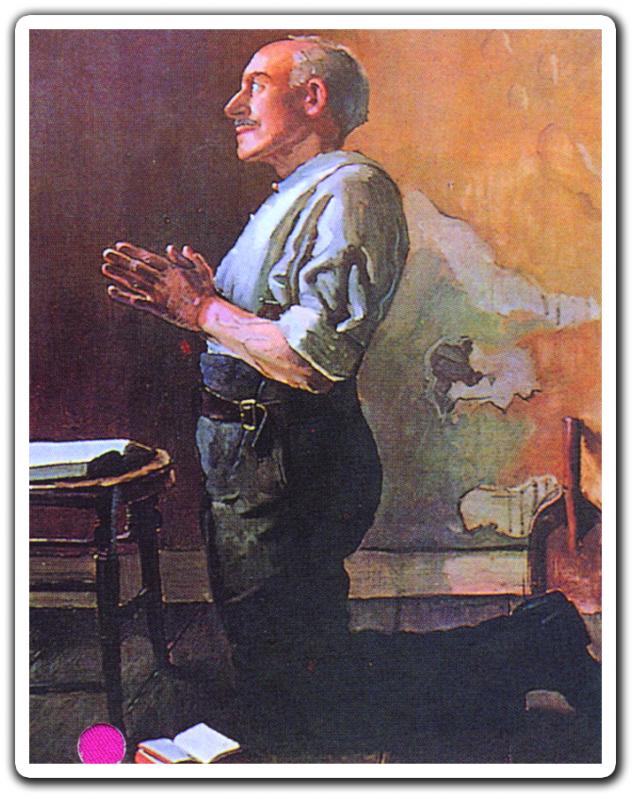 As a child I used to go on
Holiday to an aunt who lived in Parnell Square, Dublin, and every morning would attend Mass in St Saviour’s Church, Dominick Street. To get to Dominick St, I would walk through Granby Lane, where I would stop to pray at the spot where Matt Talbot, the Workers’ Saint, died. It was during those years that I developed a devotion to him that has lasted to this day.
As a child I used to go on
Holiday to an aunt who lived in Parnell Square, Dublin, and every morning would attend Mass in St Saviour’s Church, Dominick Street. To get to Dominick St, I would walk through Granby Lane, where I would stop to pray at the spot where Matt Talbot, the Workers’ Saint, died. It was during those years that I developed a devotion to him that has lasted to this day.
Last week I returned to Granby Lane, and again stood praying at the spot where he died. A cross on railings denotes the spot where he fell, and across the street, on the walls of the Salvation Army Hostel, is a marble tablet bearing the inscription: ‘Matt Talbot collapsed and died on Trinity Sunday, June 7,1925’. His cause of beatification and canonization was introduced in Rome in May, 1947.
Matt Talbot was one of 12 children – eight sons and four daughters – of Charles and Elizabeth Talbot. He was born at 13 Aldboro Court on 2 May 2 1856, and was baptized in the Pro-Cathedral three days later. He attended St Lawrence O’Toole’s Christian Brothers School for brief periods and later O’Connell Schools at North Richmond Street, which he left at the age of 12.
Road to drunkenness
Matt then went to work as a messenger boy with the firm of Messrs Edward and John Burke, wine merchants, North Lotts, Dublin, which did an extensive bottling business for Guinness and Youngers. Before he was a year in the store, he returned home drunk one evening. His father gave him a beating, removed him from Burke’s, and got him a job as a messenger boy in the Port and Docks Board, where he was in charge of the bonded stores. Sadly, it was a case of ‘out of the frying pan, into the fire’. In Burke’s the drink was stout (black beer); in the stores of the Port and Docks, it was whiskey. The men in the bonded stores gave young Matt whiskey to drink, and thus began his road to drunkenness.
At 17 he became a bricklayer’s laborer with Pembertons, the building contractors. He was an excellent workman and a great timekeeper but after work would go with companions to neighboring public houses (taverns) and shebeens (illegal taverns) to drink until closing time or until the money was spent.
Sometimes on Saturdays, pay day, he would give his 18 shillings wages to the owner of a public house. He would be drunk by Tuesday, and when the money was gone, he would pawn his boots to buy drink, and walk home in his stockinged feet. On one occasion, when drinking with friends, a fiddler (violin player) joined them. When the money was running short, Matt took the fiddle and pawned it. He then returned with the money and bought more drink. It wasn’t until the party broke up that the fiddler realized that his means of livelihood was gone. Years later Matt searched the city for the fiddler and, not finding him, had Masses offered as restitution.
But, no matter how much drink he had the night before, he was always in time for work at 6am.
Changed his life
 When Matt was 28-years-old, an incident occurred that changed his entire life. For a week he had stayed away from work, drinking heavily. Saturday found him sober, thirsty and penniless. But confident that his workmates, for whom he had often bought drink, would come to his assistance, he stood with his brother near O’Meara’s pub on the North Strand to meet his colleagues coming from Pembertons. The men passed in twos and threes but none stopped to ask the brothers to have a drink. Matt said later that he was ‘cut to the heart’ by this treatment and went home.
When Matt was 28-years-old, an incident occurred that changed his entire life. For a week he had stayed away from work, drinking heavily. Saturday found him sober, thirsty and penniless. But confident that his workmates, for whom he had often bought drink, would come to his assistance, he stood with his brother near O’Meara’s pub on the North Strand to meet his colleagues coming from Pembertons. The men passed in twos and threes but none stopped to ask the brothers to have a drink. Matt said later that he was ‘cut to the heart’ by this treatment and went home.
His mother, preparing the midday meal, looked up with surprise, and exclaimed, ‘Matt, you’re home early and you’re sober’. After the meal, he turned to his mother and said, ‘I’m going to take the pledge’ (a promise to God not to drink). As he left the house she said, gently, ‘God give you strength to keep it’. Matt went to Holy Cross Church and, according to his own account, went to confession and took the pledge from Rev Dr Keane. He kept that pledge until his death 41 years later.
From that time on he attended Mass daily at 5am. in St Francis Xavier’s church, Upper Gardiner Street, before going to work at 6am. After his evening meal at home he walked to a church on the north side of the city, either St Peter’s, Phibsboro, or Berkeley Road, where he prayed until it was time to go to bed. This was to avoid the temptation of meeting his former drinking companions as the effort to quell the craving for drink was causing him immense suffering.
Every week evening, every Saturday afternoon, and every Sunday morning was spent in church. He gave up all company and confided only in his mother. When Fr John Cullen, a Jesuit priest attached to Gardiner Street Church, founded the Pioneer Total Abstinence Association (pioneertotal.ie/pioneer/) in 1898 Matt became one of its first members.
Prayer and mortification
Matt Talbot mortified himself rigorously. He slept on a plank bed with a piece of timber for a pillow. This left his face numb in later years. He slept in chains which he wore for 14 years before his death, round his leg and on his body.
He prayed each night from 2 to 4 am, then dressed and prayed again until it was time to leave for Mass in St Francis Xavier’s church. He would arrive at 5am, if not earlier, and would kneel in prayer at the church’s iron railings, waiting for it to open. On entering he would kneel and kiss the ground, then make the Stations of the Cross.
In 1892 Matt took up employment as a bricklayer’s laborer with the firm of T&C Martin, on the North Wall, where he remained until his death. He fasted constantly. His breakfast consisted of cocoa prepared the previous evening by his sister, which he often drank cold. With this he ate some dry bread. For his midday meal he had cocoa to which he would add a pinch of tea, and again drank cold. With this he took a slice of bread. His sister would bring him a small evening meal. If she brought fish he would insist that she take it home with her and would make do with bread soaked in the fish juice.
On Sundays he remained in the church for every Mass. Only on returning to his room at about 2pm would he break his fast for the first time since 6:30pm. the previous day. The remainder of the day was spent in prayer, reading the Scriptures and the lives of the saints. He gave all his money to neighbors in need and to the missions.
Collapsed and died
Matt was on his way to Mass in St Saviour’s on Trinity Sunday, 7 June 1925, when he collapsed and died on Granby Lane. A paragraph in the Irish Independent of the following day stated, ‘An elderly man collapsed in Granby Lane yesterday and, on being taken to Jervis Street Hospital, was found to be dead. He was wearing a tweed suit, but there was nothing to indicate who he was’. He was buried the following Thursday, the feast of Corpus Christi, in Glasnevin Cemetery.
In 1952 Matt Talbot’s remains were exhumed and transferred to a double coffin bearing the inscription, ‘The Servant of God, Matthew Talbot’. The coffin was placed in a vault in the central circle of the cemetery to which pilgrims began to flock from all over the world.
In 1972 Matt Talbot’s remains were removed to the Church of Our Lady of Lourdes in Sean McDermott Street. The tomb has a glass panel through which the coffin may be seen.
Anyone who receives a favor through the intercession of Matt Talbot is requested to write to Very Rev Fr John Flaherty, Administrator, St Mary’s Pro-Cathedral, 83 Marlborough Street, DUBLIN 1, IRELAND.
This article, used with permission, first appeared in Reality (July-August 1999), a publication of the Irish Redemptorists, and appears on www.catholicireland.net. The website of Reality iswww.redemptoristpublications.com/reality_magazine.htm. That of its sister publication, Face Up, ‘For Teens Who Want Something Deeper’, is www.faceup.ie.
My Memories With Muslims
By Frater Felmar Castrodes Fiel SVD
 The author is studying for the priesthood as a member of the Society of the Divine Word (SVD) where seminarians in vows are known as ‘Frater’, the Latin for ‘Brother’.
The author is studying for the priesthood as a member of the Society of the Divine Word (SVD) where seminarians in vows are known as ‘Frater’, the Latin for ‘Brother’.
I once lived in a Catholic compound surrounded by Muslims. I was still in Grade Two when my parents decided that I should live with my grandparents to continue my studies. This was hard for me since it meant new acquaintances, new surroundings and a new school.
Divided world
My grandparents lived in a bank house [editor’s note: this is a compound provided by the lumber company for its employees, where they work and also live with their families] and all our neighbors inside the compound were Catholics. Interestingly, I could see other people as I peeped through the wooden wall. Every now and then, one or two would come near the well inside our compound and catch a Catholic’s attention. There was a store catering to their needs for ice-water, ice-candy and buco juice. These people would ask the Catholics’ favor to buy them one or two of these products. That was the only relationship between our people and those on the other side.
My friends told me not to go near these people because they were Muslims. They said that Muslims were cruel and bad, aside from being traitors. I could not understand why they made such a judgment until, one time, when a group of Catholic children happened to play on the shoreline, the Muslim children at the other side of the compound saw us and they began to stone us! We panicked and also retaliated. We also stoned them. I remembered vividly a big stone hitting my foot. It was painful. I went home with hatred in my heart.
Much more in school
I had many Muslim classmates. How they liked to get things from my trolley! They even stole my snacks! I saw them!
That time all I understood of why we Catholics lived in a wooden-walled compound separated from the Muslims was the fact that we could not live peacefully together. Muslims hated Catholics and we Catholics hated them. Even the long shoreline in our place was divided – there was a ‘Catholic’ shoreline and a ‘Muslim’ shoreline with dividing walls between them. No Catholic would step on the ‘Muslim’ shoreline nor would they step on ours. We did not fish on their territory as they also did not fish in ours.
When world views collapsed
I was not able to finish my schooling in that place. My mother took me back and I became a transferee in the school where I had done Grade One. Luckily for me, there were no Muslims in my hometown. I grew up and eventually entered the seminary to become a religious missionary. Our congregation has been advocating inter-religious dialogue and I was a bit skeptical with our thrust since the Muslims I grew up with were quarrelsome. All I believed was that all Muslims should be under suspicion since they were cruel and bad, aside from being traitors.
Until I met John
He was a college student in Davao and he became one of my friends during summer classes. We bonded very well, shared notes and talked about everything under the sun – well, almost. I thought I knew him very well since he appeared to me to be very kind and friendly.
Then the big day came. While we were having our regular stroll-in-the-mall-after-classes, I invited him in a restaurant. This time I ordered chicharong baboy.
‘Alam mo, hindi ako kumakain ng baboy (You know, I don’t eat pork)’, he said politely.
I cracked a joke, ‘Why? Are you Muslim?’ I asked him.
‘Yes.’ He answered.
‘Huh?’ I was very surprised.
Finally, a bridge
That very moment, all my biases against Muslims collapsed. Lo and behold, before me was a Muslim, and I did not have even a slightest hint that he was among the people I hated, if not cursed. He was kind, friendly and charitable – characteristics I saw only in my more-preferred Christian friends. He turned my biases upside down!
‘How come you have a Christian name – John?’ I curiously asked.
‘My real name is Janal. My nickname is John’. He smiled with a little laugh.
That day we started talking about our religions and it paved way for the start of a very beautiful story of friendship. John or Janal opened my eyes to the fact that not all of his people were bad. Many of them, in fact, are peace-loving and kind people. Muslims and Catholics have many things in common. We have good people and they have good people too. On both sides, we have problematic members of society and no one really has the right to make harsh judgments against another. I do not blame my friends who told me when I was young that Muslims were bad people. They were also shaped by other people’s biased worldview.
John had the same sentiment. He also didn’t have a healthy mindset towards Christians, Catholics especially. He was programmed that Catholics were cruel and bad, aside from being traitors.
With him, I learned basic respect for any person’s religion. It gave me joy to know him because he made me appreciate all the more the beauty of my own religion, as he also felt that his encounter with me made him love his religion more deeply.
A child’s prayer
I went back to that compound two years ago and the wall that divided the Catholics from the Muslims was still standing. As I conversed with my own people, I coupled it with a prayer that both sides may be more open and learn to extend a hand. After all, we are still brothers and sisters.
You may email the author at fielsvd@yahoo.com
Our Hideaway
A venue for the youth to express themselves and to share with our readers their mind, their heart and their soul. We are inviting you – students and young professionals – to drop by Our Hideaway and let us know how you are doing.
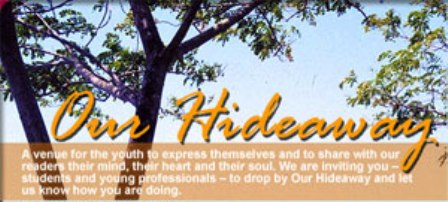
The Way I Remember ‘Daday”
By Faith S. Lagos
In our lives we experience a lot of things which shape our future.
I was born into a family where everyone believes in God, that God is always the center of our lives. My  father is the most disciplined and loving father. My mother is the light of our family. She is a teacher, a good counselor and the most caring mother in the whole world. My brother is the most handsome brother of all. He loves to play the keyboard and to drive me to school. My sisters are beautiful and charming. My sister Joy is a good singer while my sister Charie is a beauty queen in her own right. I, Faith, am the apple of their eye. I’m the youngest in the family.
father is the most disciplined and loving father. My mother is the light of our family. She is a teacher, a good counselor and the most caring mother in the whole world. My brother is the most handsome brother of all. He loves to play the keyboard and to drive me to school. My sisters are beautiful and charming. My sister Joy is a good singer while my sister Charie is a beauty queen in her own right. I, Faith, am the apple of their eye. I’m the youngest in the family.
We live in a small town named Dueñas. It’s a one-hour drive from the city. It’s a place where people know one other. I live in a two-hectare compound. My grandparents live with us too.
When I was young, I remember the day our grand-aunt treated us to lunch in my favorite restaurant. It was the most memorable day in my life. I enjoyed her company. We often called her ‘Daday’. She was a retired principal. Aside from that, she was an old maid. She devoted her entire life to teaching because she believed that education was the most important thing in our life. Sometimes she was strict, but in spite of that we believed that she loved us and we loved her very much.
A few years ago, we went to the doctor for a general check-up for our grand-aunt. The doctor told us that she had cancer and that the cancer was already in its last stage. We felt bad about the news. It was unexpected. More so, unbelievable and impossible.
According to the doctor, the cancer was already all throughout her body and that no medication or operation could lengthen her life. It was terrible. I cried upon hearing the news. All of us felt that it was the end of the world. But we never failed to put our trust in God. We prayed and prayed but I think the time had come for her to live in a better place. A place where there is no pain, no hurt, no suffering, and that is HEAVEN.
She passed away two years ago. It was a sunny Sunday morning and all of us were at home busily preparing to go to church. I glimpsed her lying in her bed. She looked thin, pale and lifeless. I felt pity and sad. We didn’t expect that on that day she would pass away. I cried and cried all day but it was no use. She was gone.
Life is short. Life is full of surprises. There are times when you are on top of the world and times when you are down. All we have to do is look up, to look at the brighter side of life. Do something good. Do something worth remembering.
As the song goes, ‘God is in control, and He loves and cares for you’. Let us remember that God is still there to guide and help us in our every endeavor. Just don’t give up: put your faith in God.
Send us your story (500 to 1,000 words) to PO Box 588, 6100 Bacolod City
or email it to us at editor@misyononline.com Don’t forget your picture. It makes the difference.
Sunflowers Bloom In Summer
By Fr Geraldo Costa CICM

First buds
It was in January 2004 when the plan of holding a `summer camp' for the street children of Manila was conceptualized. Filled with great enthusiasm, I sat down with two Sunflower staffers and Ms Geraldine B. Sanil, then Acting Director of the Guidance Center of Saint Louis University (SLU), Baguio City. We began brainstorming on how to set the wheels in motion, especially if the first camp was to be held that summer. With this small group, we were able to draw a rough outline of activities, and it was from this outline that the camp's title was derived: `A Sunflower is Growing on the Hill _ A Developmental Camp'. The title itself gives an idea what the camp is all about. It is a camp that aims to help abused and street children of Manila to arrive at insights that will lead to greater self-understanding. We want them, like a growing sunflower, to be able to face and follow the bright rays of the sun as they cope with their concerns and become more effective individuals. It is still a summer camp, but what makes it one of a kind is the inspiration to integrate fun activities with therapeutic interventions that will help the children in facing specific problems in their psycho-emotional-social development.
Following the foregoing concept, Sunflower Children's Center spearheaded the first Developmental Camp in April of 2004. It was a three-week camp held on the picturesque hill of Bukal ng Tipan, Taytay, Rizal. The team of facilitators would attest to its awe-inspiring success. From the very beginning, the plan was to make the Developmental Camp a yearly special project in line with the Center's program on advocacy and promotion of children's rights. In the summer of 2005, we were supposed to have a follow-up Developmental Camp serving the children of the previous camp, but it did not push through because the partner institution had other plans for that summer. Nonetheless, preparations for the next camp, in 2006, began as early as the following January. Because of the past experience with the first camp, the planning stage was easier. Armed with overflowing zeal and putting to heart the goals of the project, the Sunflower team (including Sunflower staff, three guidance counselors and one psychometrician from the SLU Guidance Center, one guidance counselor from the SLU Lab Elementary School, and one project employee who helped in the psychological testing) went to Bukal ng Tipan to carry out the plans and once again realize the camp's objectives.
Healing play
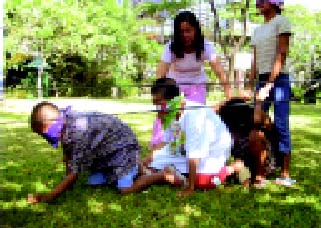
Sunflower care
Following the formal end to the camp, for the Sunflower team there was still a week of hard work, since official reports had to be generated incorporating the assessment results and the information and observations gleaned from the individual therapy sessions, group dynamics activities and the day-to-day events of the camp. Inspired by warm memories and not losing sight of the camp's objectives, we were able to finish all the psychological reports in time for the final meeting with the social workers of Kanlungan sa ER-MA Ministry at the CICM Provincial House in Quezon City. During this meeting, four members of the Sunflower team shared the findings and, more importantly, the recommendations with the ER-MA staff. It was a chance to openly discuss the actual interventions that the staff and the institution could provide to help the children in their psycho-social-emotional growth and development.
At present, Sunflower's link with Kanlungan sa ER-Ma Ministry is being continuously nurtured through therapy sessions that I am having with some children from the institution. Twice a month, I go down to Bukal ng Tipan for these sessions. This goes to show that the Developmental Camp is a con-tinuous commit-ment to helping children reach their potential, despite the odds. This, in itself, is a testimony that in-deed, sunflowers (in this case, the children) bloom all year round with proper care and attention given them by concerned caregivers.
The Sunflower team's most memorable experiences:
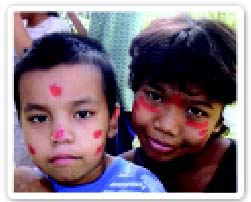
`Watching a child sitting on the grass and just spending time there . . . it made me realize that when taken in moments, life shows its perfections.' Criselda Marzo, Associate Child Therapist, Sunflower Children's Center, SLU
`Exploring a part of the hill to look for tuko (a type of lizard) in the darkness of the night, the kids brought out my sense of adventure and appreciation for what others might find mundane.' Faridah Kristi Cabbigat, Assistant Director, SLU
`When a child asked me to draw something for him and I knew that I really cannot draw, He started to whine and he moved away from me. When I started to converse with him, he said in Tagalog, "Do I know you?" I was quite embarrassed.' Jeremy Lee dela Cruz, Psychometrician
Most important lessons that the Sunflower team learned from the children:
`Hope . . . that amidst all the uncertainties and frustrations in life, there are far greater, beautiful things in store for everyone. The children also taught me to be a responsible kuya (older brother), how to be a part of the family whose members are bound by love, compassion and understanding, putting aside all differences.' Jeremy Lee dela Cruz
`A hug signifies much of what is inside one's heart. I was really moved when a child gave me a very spontaneous hug then a "thank you" after I cleaned his wounds. . . Therapy might be to give a child a hand and to walk together telling stories _ going up and down the stairs with one of my clients had more meaning for the child than the therapies. In those moments, he would insist on holding my hand. . . Respect is all one needs to start a personal change.' Fr Geraldo Costa CICM
`The children taught me the value of a simple life and how one can be happy even with simple things. Even
though they went through so many difficulties in their young lives, they express such joy and contentment when they are simply playing, and we got to share that joy with the kids during the camp.' Criselda Marzo
`Recognize and thank the Lord for every little blessing that you receive. They may not completely make you happy but they could slowly fill that emptiness in you.' Aileen Jam Mendoza
`The kids taught me that no matter how young (or in my case, how old) you are, no obstacle and problem is too big. We all have strengths that will help us overcome whatever problems we may encounter. Also, they taught me to appreciate my blessings, no matter how simple and small they are.' Rosemond Joyce Ruiz
`That my problems are petty compared to what they have been through. They made me see and appreciate how good my life has been (despite the bumps along the way) and that I should not complain. . . Be generous in showing our appreciation of children _ touch them, make them feel special.' Mary Catherine Peña
`Being with the children reminded me that despite life's imperfections, happiness can be found in the most trivial things. Adults though we are, there are times when we need to be in touch with the child within if we are to keep away feelings of bitterness and cynicism amidst trying circumstances.' Faridah Kristi Cabbigat
`The most important lesson is the key concept of the "NOW" in Gestalt Psychology. . . The past is gone and the future has yet to reveal itself and I find myself useful and grateful for the present.' Triceayn Marie de Guzman n
Even though they went through so many difficulties in their young lives, they express such joy and contentment ...
The Heart's Hunger
By Junjun Paña Bonhayag
The story of my life started when my mother and father fell in love and got married in Immaculate Conception Parish, Catigbian, Bohol, in 1970. I came into existence on 3 September 1983.
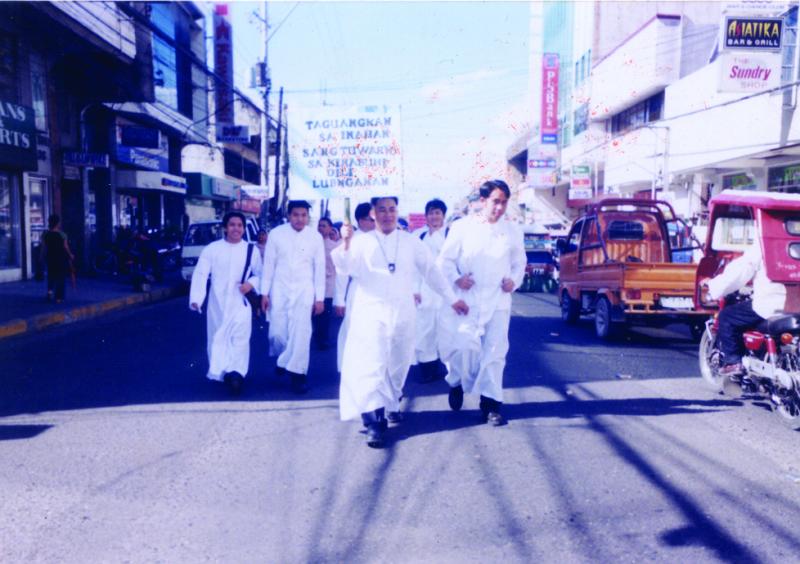
My childhood years had been chock-full of historic bits and pieces – a life mixed with happiness and sadness, love and hatred, wellness and suffering. Though a weak and sickly child, my parents unwaveringly took good care of me.
Once I was hospitalized for a week. Members of our family, except my parents, felt hopeless about my health situation. Despite my pneumonia, my loving parents enthusiastically continued their unalterable love and care.
I can still remember my compassionate mother and my protective father during my agony in the hospital room. Their loving presence psychologically increased my vim and vigor until I recovered.
I was still young when my parents, particularly my mother, introduced me to the Church. They would always bring me when they attended Mass on Sundays. Reaching the age of maturity, I was influenced by my classmates to join some religious activities in our school and parish. As a freshman in our parochial school, I entered church organizations like the Knights of the Altar, Youth for Christ and Parish Youth Ministry. Moreover, I joined some school organizations also for I delighted in serving that way. That opened new horizons for me.
Fortunately, when I was a teenager, God gave me a good life and a healthy body. This chapter of my life was in contrast to my childhood experience. More than this, I became a gung-ho athlete in school, competing in various places with diverse long-distance runners. My heart’s hunger, which I experienced within me so many times, was overshadowed by great fun and elation.
When I reached second year high school, our parish priest, who was also our school director, offered me the option of living in the convent. There I became acquainted with priestly life. It was in this encounter that my desire for the priesthood progressed. There I learned simple and complicated things. I was taught the spirit of service and leadership and gained deep values. I was jubilant. The hunger of my heart was satisfied and fulfilled.
But having been victorious and pleased, the desire for priesthood slowly diminished. My mind was diverted to other concerns. I wanted to take a Bachelor of Science degree in Marine Transportation in PMI Colleges. I also wanted to join the PMA in Baguio City for I had a little background in military discipline from our Citizen Army Training in high school.
There started my confusions and doubts. My mind wandered, my heart starved. I was caught in a dilemma. I was wandering not knowing where to go. I was like a roaring lion looking for someone to devour but could not find one. I grumbled and moaned. I already had something in me but then it was not enough to fill the weary and thirsty soul – my hungry heart. I wanted to have an end to my endeavor but I could not find it. In my happy moments, I experienced a strange sense of limitation and of longing for something else.
My heart’s hunger began to be filled when I met some seminarians from various seminaries having their vocations campaign in November 1999. I came to see that the hunger deep in my heart was a hunger for God. So with the desire to follow Christ, I took the entrance examinations for the Barnabite Order in Manila and for Immaculate Heart of Mary Seminary in Tagbilaran City, Bohol. Thank God, I passed all the requirements for the two minor seminaries prior to my entrance.
I am happy living in the seminary for seven long years. I am blissful entrusting my whole life to the priestly vocation. I graduated from college at the Immaculate Heart of Mary Seminary in Bohol in March 2004. Now I’m pursuing my theological studies in Cagayan de Oro City – where my heart belongs.
My heart’s hunger is filled, eventually, by God alone.
You may email the author at musuq-05@yahoo.com.
To Search is to Find

Is it okay to be late for Mass?
No, it’s not okay to deliberately choose to be late for Sunday Mass.
If you were invited to a wedding or to a birthday party would you deliberately choose to be late?
When I go home to Ireland I am still astonished at the number of people who leave Sunday Mass early. Some of the same people arrive late. This goes back to the old days when the Church said that in order to fulfill the Sunday obligation you had to be there before the Offertory and had to remain at least until the priest took Holy Communion. In those days the readings were in Latin and many people didn’t receive Holy Communion. But the Church wants us to get away from that legalist, minimalist mentality and to take part as fully as we can in the Holy Sacrifice of the Mass, because Jesus has asked us to do this. From the very beginnings of Christianity the followers of Jesus ‘devoted themselves to the apostles' teaching and fellowship, to the breaking of bread and the prayers’ (Acts 2:42).
The first part of the Mass, the Liturgy of the Word, is just as important as the second part, the Liturgy of the Eucharist. We could hardly apply the words ‘they devoted themselves to the apostles’ teaching’ to those who deliberately choose to be late for Sunday Mass and who don’t want to listen to the Word of the Lord. Nor could we describe those who simply want to fulfill an obligation as quickly as possible as being devoted to fellowship, that is to the other members of the Church, which is the Body of Christ.
There are occasions when we can’t avoid being late for Sunday Mass. Unforeseen events can delay us. Some time ago in my own parish in Ireland I noticed a Filipino family arriving late for Sunday Mass. But they had a little baby and went up to the front of the church. What was nicest of all was that the father, not the mother, was carrying the infant. He reminded me of my own father. (See response to the first question). Clearly that family had made a real effort to be on time and weren’t very late.
But I think that trying to get by with the least effort, choosing to arrive late and/or to leave early, is hardly a respectful and loving response to Jesus the Risen Lord, God who became Man, who freely chose to die an awful death for us on the Cross.
Pope Benedict XVI in Sacramentum Caritatis, (The Sacrament of Charity) signed 22 February, writes, ‘The liturgy of the word and the Eucharistic liturgy, with the rites of introduction and conclusion, “are so closely interconnected that they form but one single act of worship”.’
To Search is to Find: BABIES AT MASS

BABIES AT MASS
Is it okay to bring noisy, loud and restless babies/toddlers to Mass?
Last Sunday in a church in England, where I am as I write this, I told the people about the time when I was not yet three when I was ordered out of the church along with my pregnant mother. It was during a weekday Mass after Christmas and I shouted ‘Ba-ba’ at the infant in the crib. I’m sure the priest had ‘got out of bed on the wrong side’ that morning, as we say in Ireland. I told the people on Sunday that what happened especially to my mother – it was a traumatic experience for her – has always reminded me to be patient with noisy children in church. Later during my homily a baby of one year began to cry and I said ‘He must have been listening to my story’. Everyone laughed and the baby stopped crying.
This issue is one on which people have different opinions, nearly all for good reasons. I cannot remember not going to Mass. My brother is three years younger than me and when he was an infant my father took me to Mass while my mother went to a later one. It was always my father who took me, not my mother, and I’m grateful for his example. He went to Mass everyday right up to the day he died twenty years ago.
I think it’s a matter of common sense. I’ve often seen two parents at Mass with a young child. If the child gets noisy for whatever reason one will often take the infant outside for a while. I think that’s a good thing to do. Some churches in the USA and in England have ‘crying rooms’ that are soundproof but where parents can participate fully in the Mass, seeing the altar clearly and hearing everything. But the people outside don’t hear the children crying. I haven’t come across ‘crying rooms’ in the Philippines.
If a child is very noisy and screaming, for example, I think that one of the parents, or the adult accompanying the child, should take him outside. If the child always causes a disturbance at Mass maybe the best thing is to not bring him until he’s gone through that stage. It doesn’t last forever!
Something I’ve noticed often enough in the Philippines is that the adult in charge of a child is too embarrassed and/or too lenient with a child who’s running around. On occasion I’ve had to gently ask the adult in charge to take the child in hand. In some barrio chapels I used to be really distracted by small children dropping coins on the concrete floor. I think that adults with small children who allow them to run around and make noise are not being particularly helpful to the rest of the congregation.
However, basically I think that babies in arms and toddlers should be brought to Mass every Sunday by their parents. This is one very powerful way of nurturing their faith. If they become troublesome they can simply be brought outside.
Tommy, His Mother And I
By Fr Bobby Gilmore SSC
Fr Bobby Gilmore, a Columban from Ireland and a regular contributor to these pages, spent many years in Mindanao and later in Jamaica. He then worked with Irish migrants in Britain where, with others, he helped secure the release of a group of Irishmen wrongly jailed for a bombing. He is the Chairperson of the Migrant Rights Centre in Dublin (www.mrci.ie). Here he reflects on the heartbreak involved in emigration, drawing on an experience while in Jamaica. For Jamaicans the ‘Barrel’ symbolizes everything that the Balikbayan Box does for Filipinos.
A crisis of papers unfixed,
two three jobs as a domestic
and weathering the cold,
the barrel
in her kitchen-corner
a ship’s hold, constantly
waiting to be filled –
This time bargain clothes,
employers’ cast-offs
for the children back home
(Grace Nichols, Jamaican poet)
The words of the poem by Grace Nichols depict a situation that exists not just in Jamaica and the Caribbean but around the world where women have to leave home and children to find a life.
The Human Factor
The fracture in primary relationships between mother and child is profound with lasting ache and distress on both sides that do not register when immigrant remittances are discussed. Few at home realize the distress of the woman depicted in Grace Nichols’ poem. In Jamaica the children left behind by immigrants are called ‘Barrel Children’. Regularly, throughout the year they receive barrels of food and clothing from absent parents around the world. These barrels are symbols of love, affection and care, an effort to bridge gaps of loss and loneliness. For those immigrants who are undocumented, these gaps cannot be filled by occasional visits home.
Tommy’s Case
One morning Marian, the housekeeper at the rectory, informed me that a young man by the name of Tommy wanted to see me. He was a fine, handsome, young fellow of about twenty-five and well dressed. I opened the grill and invited him in. He started to talk with an American accent and after a few words this dissolved into terrible stammering. To make him feel at ease I offered him coffee. But the stammering did not cease. He told me with great difficulty about himself, that he lived with his grandmother since his mother departed for America when he was five years old. His mother lived in New York. She regularly sent back money and barrels of clothes for him and his grandmother.
Tommy’s problem was that he was unable to write to his mother. He was illiterate. His grandmother, being illiterate herself, did not value education, the need to be able to read and write. She was lax in making sure that Tommy went to school. At the onset of the stammering after his mother left, Tommy was reluctant to go to school because his fellow students made fun of him. Here he was now asking me to write a letter to his mother. It was one of the most difficult pastoral tasks that I ever took on. It was tedious trying to get Tommy to express himself and putting in words not just what he verbally expressed but what his heart wished to say to his mother who was physically absent but lovingly present. After I had finished the letter and Tommy was off to the post office, Marian the housekeeper, watching Tommy walk across the yard said in the local patois, ‘Stammer start after him mother leave for foreign. It must be shock of mother leave. Him granny could not get him to school cause him ashamed of him words’. The incident gave me an insight into an aspect of migration that is seldom thought about.
Trying to compensate
People like Tommy’s mother decide to leave in the hope of a better life for themselves and to improve the lot of the people left behind. Remittance is the word used to describe a transaction between emigrants and their people at home. It is generally a monetary contribution from an immigrant’s earnings to keep the food on the table at home. Of course it can also take the form of barrels of food, clothing, furniture and other goods. Formerly, immigrant remittances got hardly a passing mention on government balance sheets even though they were a welcome package that boosted foreign exchange.
The value of emigrant remittances
It is estimated that Ireland benefited to the tune of five billion pounds sterling from Irish emigrants to Britain between 1950 and1965. There was hardly any recognition of this by Irish governments until recently. Indeed, Irish emigrants were an unnoticed sector of Irish life unless of course they were successful and made a name for themselves overseas. The successful were acclaimed, owned and fêted. Those who sent remittances, like Tommy’s mother, were forgotten, unconsidered. Lately, emigrant remittances have become an important issue because they have become more important than foreign direct investment from multi-national companies. In Ghana, for example, foreign direct investment is worth three percent of the national income, remittances ten to fifteen percent. In most developing countries, emigrant remittances are the cornerstone of foreign exchange earnings used to pay international debts. In Jamaica emigrant remittances generate almost as much foreign exchange as the primary industry, tourism. The daily queues outside post offices and money-transfer agencies are evidence of the dependency of people at home on money originating from abroad. Worldwide, last year emigrant remittances totaled US$230 billion. The world’s aid budget was US$105 billion.
Banking and remittances
Of course this is a boom for the banking and money-transfer agencies which usually charge from five to eight percent for such transfers. One would imagine that those institutions would give consideration to immigrants and their dependants, people such as Tommy’s mother, who are easily identified. At last, having realized the importance of remittances, the Department for International Development in Britain has set up a website: www.sendmoneyhome.org to increase information about money transfer facilities in the hope of bringing down charges by creating competition. Even the World Bank and the British Bankers’ Association have begun to acknowledge the importance of remittances and have promised to work with the Department of International Development in Britain to make transfers easier, less costly and more transparent.
Human suffering involved
However, while all that rising concern may be welcome news for Tommy and his mother, there is little consideration for the mental, emotional loss and stress being experienced by both, in the separation brought about by the breach in their primary mother-child relationship. While it is easy to quantify immigrant remittances in dollars, however, dollars and designer cast-offs do not fill the gap for mothers and fathers having to leave children behind. How could one quantify Tommy’s and his mother’s loss of each other and the deprivation that he has suffered by his stammer and illiteracy over the years?
In our modern, interconnected world there is considerable space for innovative thinking not just on immigrant remittances but in making migration a more beneficial experience. Surely, if a shrimp’s itinerary from a marine outlet in Mayo to a restaurant table in Beijing can be charted, why is it not possible to offer decent arrangements to immigrants to manage their affairs? In a connected-up world Tommy and his mother and millions like them who miss each other would be enriched. Is it too much to expect?
Why I Am A Columban
By Fr Chris Saenz SSC
Father Chris Saenz is based in Chile and has appeared in these pages before.
He spent part of his formation as a seminarian in the Philippines.
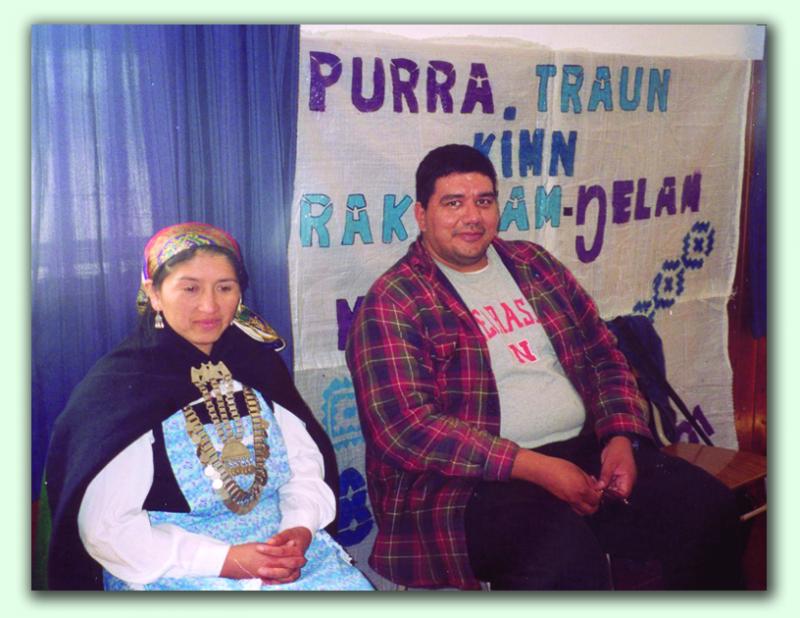 Several times I have recounted my vocational story on ‘how’ I became a Columban. Now I would like to share ‘why’ I am a Columban. I was ordained a Columban missionary priest in 2000. Since than there have been many experiences that invite a reflection on the ‘why’ but I will share one concrete experience: September 11, 2001, as a Columban priest from the United States living in Chile, my mission.
Several times I have recounted my vocational story on ‘how’ I became a Columban. Now I would like to share ‘why’ I am a Columban. I was ordained a Columban missionary priest in 2000. Since than there have been many experiences that invite a reflection on the ‘why’ but I will share one concrete experience: September 11, 2001, as a Columban priest from the United States living in Chile, my mission.
There is ‘the United States’ September 11’ and there is ‘Chile’s September 11’. On September 11, 1973, the democratically elected government of Chile was overthrown by a military dictatorship led by General Augusto Pinochet. Pinochet had the backing of the US government. Thus, September 11 provokes great tensions between pro-Pinochet and anti-Pinochet people. Often there are protests and clashes in the streets. However, in 2001 it was a quiet day as the Chilean people mourned for the victims in the United States.
Yet, it reminded me that September 11 had a tragic significance for Chile years before 2001, and with US involvement. Jesus, an Israelite living under Roman occupation was, nevertheless, questioned by a Canaanite woman whose people had been dispossessed by Israel centuries earlier. Jesus stated that he ‘was sent only to the lost sheep of the house of Israel’. The Canaanite woman’s response was sharp: ‘Yet even the dogs eat the crumbs that fall from their master’s table’ (Matthew 15, 21-28). The Chilean people challenged me to think and live more ‘globally’, beyond my own cultural and national boundaries.
The first Sunday after September 11, 2001, I went to Pancul, a remote rural chapel in southern Chile, to celebrate Mass. When I walked into the chapel I was astonished to see that the people had placed a Chilean flag with a USA flag on the altar. The people, most of whom were poor indigenous farmers, expressed their deep sorrow for the people of the United States. Furthermore, they were greatly concerned about my own family and if any relatives were affected by the tragedy. For the first time, I clearly felt the words of Ruth: ‘Where you go, I will go; where you lodge, I will lodge; your people shall be my people and your God my God’ (Ruth 1, 16).
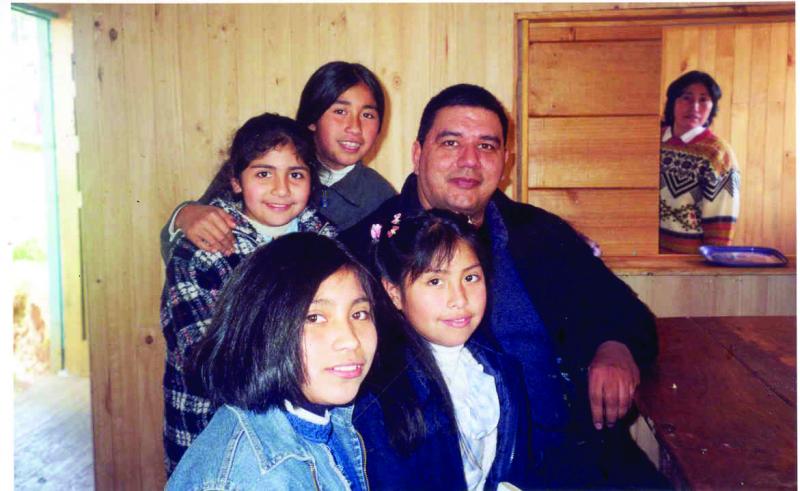 A year after September 11, 2001, I went to the United States for a short visit. When I observed the atmosphere and listened to conversations I was greatly affected by the xenophobia present in my own people. A country built on diversity and immigration of peoples was greatly losing its tradition. Furthermore, as I spoke of Chile’s September 11 and questioned some of the US governmental policies since 2001, I was looked upon as unpatriotic and disloyal by some. I was even questioned on how I could choose to live outside the United States. I truly felt Jesus’ dilemma on returning to his home place, ‘Truly I tell you, no prophet is accepted in the prophet’s hometown’ (Luke 4, 24).
A year after September 11, 2001, I went to the United States for a short visit. When I observed the atmosphere and listened to conversations I was greatly affected by the xenophobia present in my own people. A country built on diversity and immigration of peoples was greatly losing its tradition. Furthermore, as I spoke of Chile’s September 11 and questioned some of the US governmental policies since 2001, I was looked upon as unpatriotic and disloyal by some. I was even questioned on how I could choose to live outside the United States. I truly felt Jesus’ dilemma on returning to his home place, ‘Truly I tell you, no prophet is accepted in the prophet’s hometown’ (Luke 4, 24).
Why am I a Columban? I am a Columban because I can participate more fully in God’s Word by living globally, building ties with peoples of other cultures and traditions, and realizing a prophetic call. Being a Columban missionary priest has made this possible.
You may email the author at gcsz99@gmail.com or write him at: Padres de San Columbano, Casilla 311, Correo 22, SANTIAGO, CHILE.
With Christ, I Can Travel Lanao Del Norte Revisited
By Sr Rosalinda C. Gonzales MMM
Sister Rosalinda, a medical doctor, is the only Filipino member of the Medical Missionaries of Mary (MMMs), www.medical-missionaries.com, founded in Ireland more than 70 years ago by Mother Mary Martin and now with about 400 members from 19 countries. The Mercy Sisters, www.mercyinternational.ie, were also founded in Ireland by Catherine McAuley in 1831. They came to Lanao del Norte from Buffalo, New York, USA in 1957 and the Sisters are celebrating their Golden Jubilee this September. A group of Mercy Sisters came to Tacloban from Ireland in 1954.
Many years ago during the early seventies when I was younger, the call to be a religious sister was becoming more persistent while I was a government rural doctor among the poor in Lamao, Bataan.
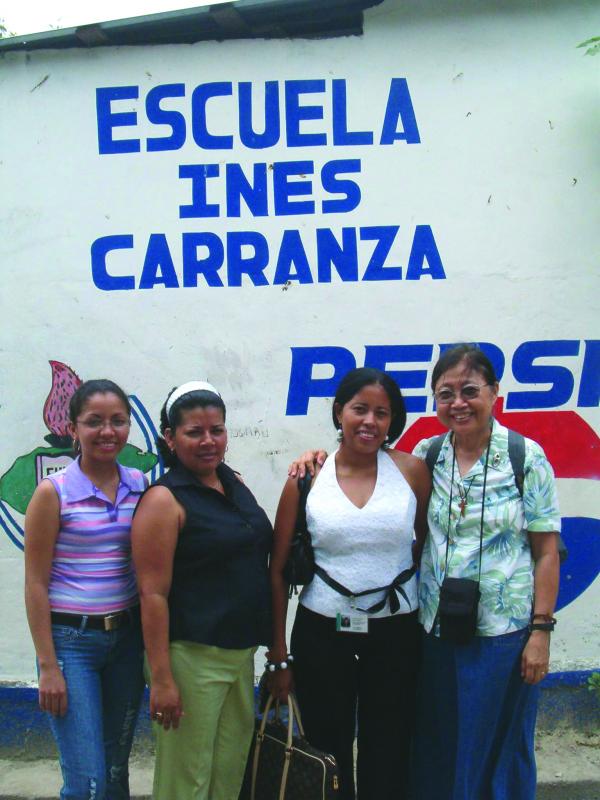
The author (first from right) with (from left) Jessica, Lilian Torres and Serini
fellow volunteers of Casa Visitacion
Door to my vocation
My close association with the Sisters of Mercy helped keep alive and nurture the seed of a religious vocation that was planted in my heart.
I had the occasion and privilege to visit the Mercy missions in Lanao del Norte. Visiting Linamon, Kolambugan, Tubod, Baroy and Kamague, Iligan City, in the then Prelature, now Diocese, of Iligan was a blessed opportunity to learn and see what religious life was all about.
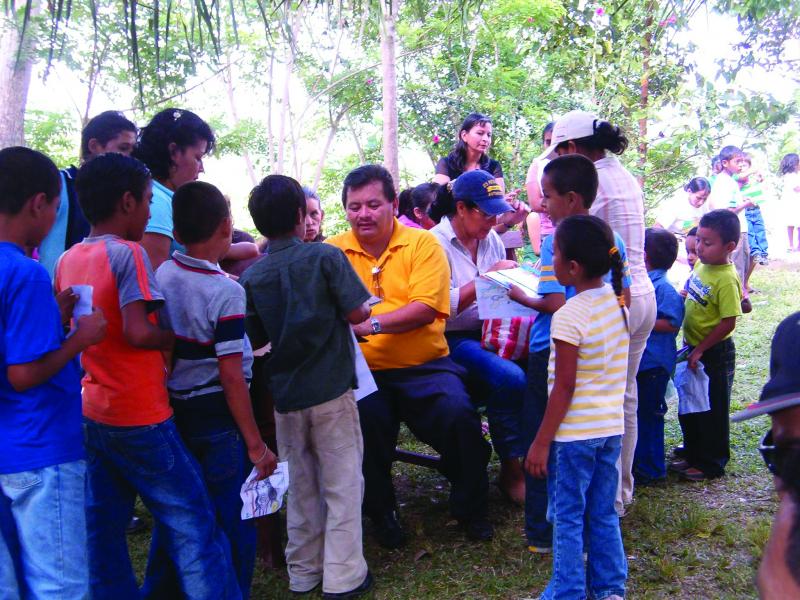
Fr Enemecio with Lilian distributing donated
clothing or other items for the poor people in
San Jose Occidental
By then the Sisters’ dream of building a hospital was already in the process of being fulfilled. While the dream was still on paper and in everyone’s hearts and prayers, Sr Rose Palacio RSM, MD, was already doing the much needed mobile medical service to the poor.
A call set aside
Family circumstances and other factors delayed my responding to my religious call. At the end of my postgraduate training, a colleague asked me to join her as a government contract worker in Nigeria, West Africa.
After I finished my work contract of two years, Bishop Lucas Olu Chukwuka Nwaezeapu of the Diocese of Warri invited me to work at St Francis Catholic Hospital, Okpara-Inland, established by the diocese in 1963,www.rsccaritas.org/wwdhcrcl2.htm.
Converging roads
Feeling this to be an experience of working already in the Lord’s vineyard, I became a lay missionary. Later on, when I opened St Joseph’s Clinic in the grounds of Warri Cathedral, Sr Carmen Hayrosa RSM arrived in Nigeria. She stayed at the convent of the Missionary Sisters of Our Lady of the Apostles in Effurun while teaching at the nearby Diocesan Minor Seminary.
Sister Carmen assisted at the clinic in her free time. When it was already earning and self-sufficient, she suggested that we go to the USA for mission appeals to equip the maternity clinic. The Mercy Sisters of Buffalo, New York, donated some medical equipment from Mercy Hospital there. A Protestant minister whom we befriended in Nigeria facilitated our visits to some evangelical churches in Chicago and Ohio which gave monetary contributions and extended their warm hospitality. The Charismatic community of Ann Arbor, Michigan, helped to get us a second-hand microscope. KLM (Koninklijke Luchtvaart Maatschappij) airlines allowed us to carry any excess luggage for free from the USA to Nigeria. Nigeria Airways did the same for our journey from Lagos to Benin City.
It is said that nothing in life is accidental. It was in Nigeria that God’s Providence brought me in touch with the Medical Missionaries of Mary.
I finished my work contract and traveled to Ireland for religious formation when I joined the MMMs in 1983. Sister Carmen eventually returned to the Philippines and we kept in contact by letter through the years. I kept in touch with the Mercy Sisters at Makati Medical Center and in Quezon City during my home leave from Tanzania, East Africa, where I was stationed after religious profession in 1986.
Working in his vineyard
After many years as a missionary in Africa, I felt that it was time to move elsewhere. I am presently on mission in Honduras, Central America, where I am involved in the practice of preventive and complementary medicine. It is a component of the MMM Project ‘Casa Visitacion’ of integrated basic health care. Our program includes care and support of persons living with HIV/AIDS, victims of domestic violence and sick persons at home. We also develop the abilities and skills of our health promoters. For me, it was a radical and welcome change from busy hospital duties and I am gradually but constantly adapting.
While on home leave from Honduras, I contacted my Mercy friends. Sister Carmen asked, ‘Why not visit us in Iligan and make your spiritual retreat here? You will renew old friendships and meet new friends’.
Renewal
When I arrived in Kamague, Iligan City, I was delighted and greatly thrilled to see the realization of a beautiful dream. The Mercy Community Hospital had already celebrated its Jubilee and was on its 30th year. It continues to realize its vision of ‘a hospital of prime quality preventive, curative and rehabilitative health care services accessible to the community of Iligan, Lanao del Norte, Lanao del Sur and neighboring areas, at an affordable cost’. Sr Rose Palacio RSM, MD, gladly gave me a guided tour and I shared her pride and joy.
My spiritual retreat went well and made me ready to return to Honduras with renewed enthusiasm, vigor and zeal in my missionary vocation. Thanks to Sr Fe Pimentel RSM who graciously guided my retreat. The quiet and prayerful atmosphere with its beautiful gardens and woods provided the appropriate environment for listening to and appreciating God in nature. Sr Elsa Caberte RSM supplied the healthy, sumptuous meals for physical nourishment to sustain and assure a ‘holistic retreat’.
I had the pleasure and privilege of joining the clergy and religious of the Diocese of Iligan for a recollection conducted by Bishop Elenito R. Galido, their bishop since September last year. This article was inspired by its theme: ‘Unity in Collaboration and Partnership in Ministry’. I received many pleasant surprises and bonuses for which I am grateful to God and the Sisters.
Indeed, my ‘vacation with the Lord’ - and with the Mercy Sisters - was a restful and memorable experience. Thank God for the gift of friends.
‘With Christ, I can travel.’
You may write the author at: Sor Rosalinda C. Gonzales MMM, Misioneras Medicas De Maria, Parroquia Nuestra Señora De Suyapa, Apartado Postal 10594, Choloma, Cortes CP 21112, HONDURAS or email her at rosgonzales@eircom.net
Yoga in Christianity
s yoga sinful or against Christian teachings?
I have never been comfortable with the attraction of some Western Catholics and other Christians for methods of prayer from Eastern religions such as Buddhism and Hinduism. Although the Philippines is part of Asia, it’s Christian tradition came from the West. Buddhism and Hinduism have never had strong roots in the country. I don’t know very much about contemplative prayer in Islam.
The Catholic Church has many traditions of prayer, including contemplative prayer. We can mention the Benedictine tradition, for example, Carmelite spirituality, Ignatian spirituality and many more. Eastern Catholics and Orthodox Christians have a strong monastic tradition.
Yoga, insofar as I know anything about it, seems to emphasize certain physical positions. We have traditional positions for praying, especially kneeling. During Mass we stand, sit and kneel. We also had traditions that were very strong before and marked us as a special group such as fasting, especially during Lent, and abstaining from meat on Fridays. (The former Spanish Empire, including the Philippines was exempted from the latter). I think we have lost something important by more or less abandoning those.
I have never been very impressed by those who profess to be Christians but ask us to admire the religious practices of other faiths while neglecting their own. There are different viewpoints on Catholics using yoga. My own tendency is to stay away from it. As a Catholic I have the Bible, the Word of God, the Sacrifice of the Mass, the Seven Sacraments, the rich prayer traditions and spirituality coming from St Benedict, St Ignatius, St Teresa of Avile, St Thérèse of Lisieux, and so on. I can sit, stand and kneel while praying formally. I can walk while praying informally. I can pray while travelling in the bus, on a plane or ship or wherever. I really don’t see any need for something esoteric such as yoga, which is associated with a faith where Jesus Christ, God who became Man, has no place.
Your Turn

The author has recently migrated to Sydney, Australia. He has contributed an article featured in Misyon’s January-February 2007 issue, Our Hideaway section.
Dear Father Seán,
Salaam Aleikum! It was in my senior year in high school that I found Misyon. My great religion teacher, Mr Eduardo Verdadero, introduced it to our class. He encouraged the writers in our class, especially me, to get published. About three years later, with both of us gone from the school, I finally did it. Idle Thoughts Past an Ash-heaven Morning was my first article to be published and what a feeling I had! My breakthrough after numerous rejections truly saved me from oblivion and furthered my understanding of that great word, ‘hope’. Now, every time I read your magazine, I remember Sir Ed because aside from pointing me towards pretty good food for my soul, in more ways than one, as my best mentor, he influenced me profoundly in the way I look at myself today.
I am inspired by the touching stories of the missionaries. Through prose and pictures alone, I come to visit different places and get a clear vista of the mission work abroad. The letters which appear in the last pages always have special meaning for me, since they show that no miles or seas can separate your readers. I picture it all as one big family where everyone is invited to look with the same heartbeat. And that is, writing for us to feel the world, and its various vistas. There exists no greater testament of one voice – a band of letters is but a prelude to the ultimate correspondence. Likewise, it tells how far-reaching the voice of God is. How pleasing it is to know that places as far away as Africa and Europe can be on the same page, at the heart of the matter. We truly need one another, don’t we? So though seas and mountains distance us, we almost always find a way back, simply to remember.
Forty Shades of Green, published in the July-August issue last year, particularly caught my attention. I liked the way Joey Puerta described Ireland and his work with the Redemptorists there. He drew some eye-watering accounts of a typical missionary’s stint, its wonders and questions, joys and tribulations. Like me, his experience of God was not always as it is now. But once he found a burning passion in himself to serve for the greater cause of sharing His kingdom, it was like an echo that kept sounding. As I continue to learn the complexities of living, what to do and what not to do, I can happily state that somehow, someway, I am indebted to Mr Puerta. He really made me stop in my careless wandering of the earth’s tracks and reconsider where I must go from here.
At first, I have to admit that I saw mission work as boring, if you want to know the truth. As I began reading the articles, this impression began to dim. Until . . .
Forty Shades of Green. My skepticism about missionaries totally shattered, I just knew at that moment that someday I too will embark on a similar mission of my own. And I see myself revisiting those places in Ireland mentioned by Mr Puerta. Judging from his account, it truly is a place to go. To each his own.
After reflecting on his musings, I surmised that there are special places for extraordinary moments in our sojourn. In the author’s case, it had to be Ireland. This was where he heard the Lord’s voice and felt his presence the strongest. As for me, I am still searching for this lost setting. In my quest to find it, I owe much to the people around, the select few who, in one way or another, would help me see the light. When someone then asks me the meaning of life, I definitely can’t get lost. Others - that is the answer. So here I am in Sydney, exploring through a mango-orange sky.
My reading of Misyon has helped me tremendously in my journey of faith. I have learned to remove the excess baggage, like material possessions, and choose the truly important ones, like love. Since stumbling on a new-found friend, I can say that I have done my best following His fold. You will know how I feel if you similarly have held something deep in your heart. Loyalty is the ticket. The lessons that I have learned from subscribing to what you preach will always stay in my heart, wherever I tread.
It is hard to tell what makes us stop in our careless wandering of the earth’s tracks and savor the freshness of its wonders. Sometimes it could just take a special magazine to renew our view of the world and instill courage to break through boundaries and find a difference. While I can wait until the winter of my life in search of its pleasant surprises, there is no doubt I would have waited too long, had it not been for Misyon. More power!
Yours with gratitude,
Christopher Ong
